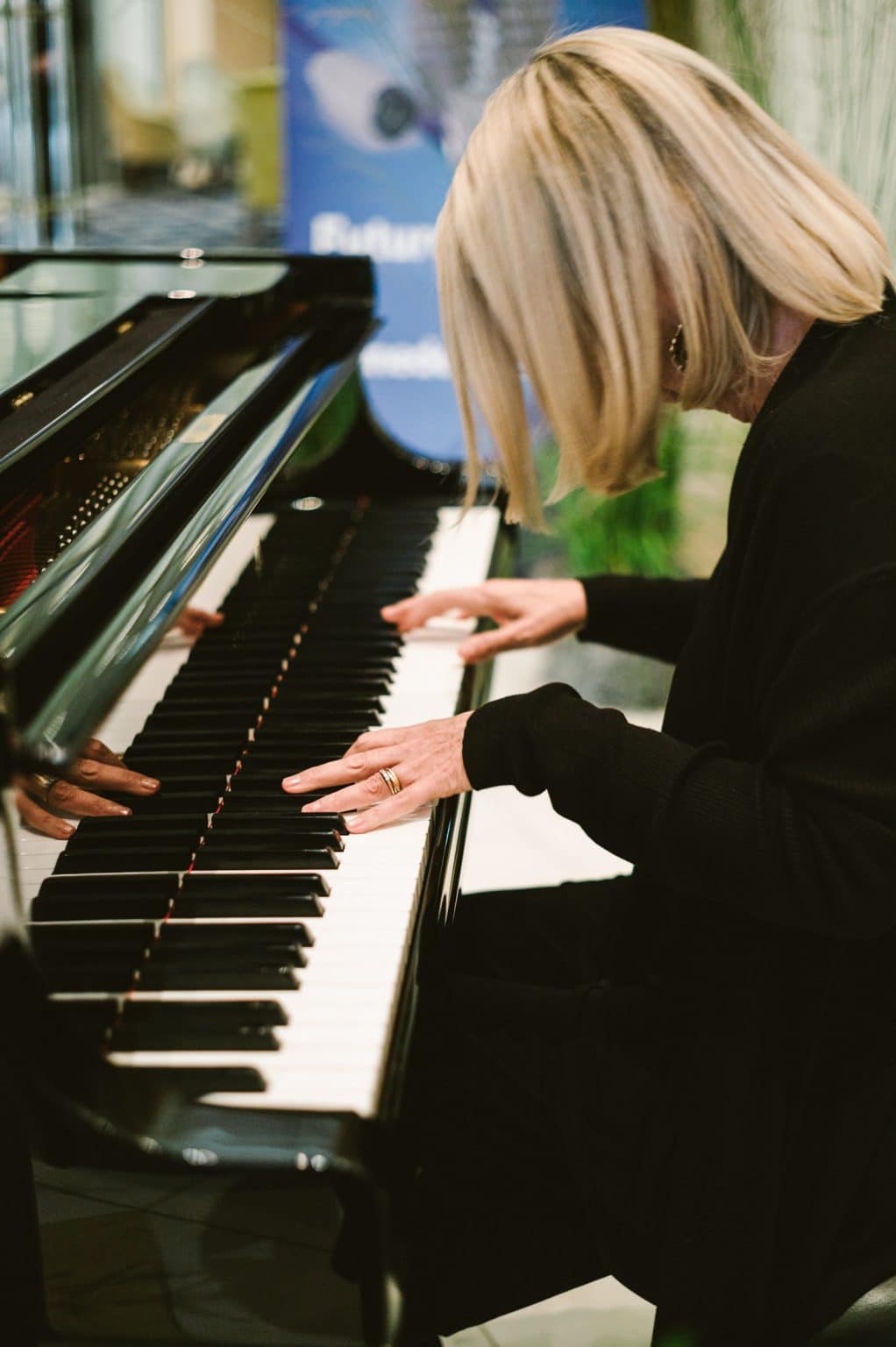
I love Paris. But just once I would like to visit when it is not hot enough to fry an oeuf on the cobblestones.
After our 2017 sun and fun-filled Parisian adventure with Robin Spielberg and Larry Kosson—also known as the sweat your ass off tour de prance—during which time we bravely climbed Montmartre and cheerfully joined drenched throngs of tourists dragging themselves through the scorched gardens of Versailles—I swore I would never again enter a land-locked European metropolis between the months of June and September. All the Aperol Spritz cocktails in the world could not convince me otherwise.
Figures that music would lure me back into the bronzed arms of the city that doesn’t sweat, it glistens. And maybe smells a little. Camembert, you might guess, doesn’t hold up well in the heat. Neither do I.
My sister, Randy, and her guitarist husband, Dale, come to Cologne, Germany, to visit us at the end of June. Built into their trip is an excursion to Paris so we can hang out with jazz-pop superstar George Benson and attend his July 1st concert on the outskirts of the city. My first thought: Paris in July? Pas encore. Uptown whining, I know. Paris is Paris. Drizzle, sizzle, it’s all good.
Background: Dale has been friends with George for decades. George Benson is one of those rare performers who has preserved his musical integrity while maintaining an unblemished celebrity status. The guy is a musical—and business—genius. I’ll risk melting in the French heat for a chance to meet him. Send in the chevre.
My husband, John, books the Thalys (high speed train) from Cologne to Paris and finds an AirBnB apartment big enough for all of us. The apartment is close to the concert venue and within walking distance of a Metro station. Randy has never been to Paris, and even though I know the city will be hotter than the gates of hell, I want to show her the things I love. Gargoyles. The Seine. Monet. Meringue as big as my head.
The day before we leave Cologne for Paris, Dale receives a phone call from George’s manager, saying that George has lost his voice during his Royal Albert Hall performance in London and must cancel the Paris concert. Doctor’s orders. In a career spanning four decades, George has only cancelled two other gigs. As a seventy-five-year-old touring musician, he gets a free pass, I suppose. But the selfish part of me wishes he could get it together to croak out a few tunes—the show must go on, and all that. I once played a Sesame Street program with a stomach virus and had to run into the wings following a rousing rendition of “Heads, Shoulders, Knees, and Toes” to vomit in a bucket held by a reluctant stage manager. I couldn’t cancel—I needed the money. George probably isn’t concerned with such trivialities at this stage in his career.
What to do. We’ve already paid for the train and apartment. So off we go to the city of blinding light, our trolley bags layered with tissue-thin black dresses, straw hats, and sandals. It’s hard work to look Parisian-chic when you’re having a July-induced hot flash—especially when the entire point of the voyage is meeting a jazz legend who has called in sick.
C’est la vie.
We arrive safely and navigate the Metro—a tubular sauna—to our apartment. Our abode has no air conditioning, no fan, and no toilet paper. Otherwise, it’s quite chic and comfortable. Dale and I take naps while John and Randy investigate the neighborhood and buy toilet paper and French snacks. John also buys me flowers, pink lilies that won’t wilt in the heat. We eat potato chips and drink coffee to revive ourselves.
“Eiffel Tower, anyone?” Since the Benson concert isn’t happening, I figure a trip to the tower might be an appropriate alternative activity and an excellent way to welcome my sister to Paris. First things first.
Dinner.
“We are vegan,” I tell the waiter in French.
“Why?” he replies in English.
I’ve learned to say, “Sans lardons, s’il vous plaît.” In France, any meal that does not include bacon seems to qualify as vegan. One takes what one can get. Close your eyes and think of tofu.
We jump back on the Metro and head to the Trocadero, my favorite viewing spot for the tower. The Eiffel Tower never fails to thrill me. Legos for adults.
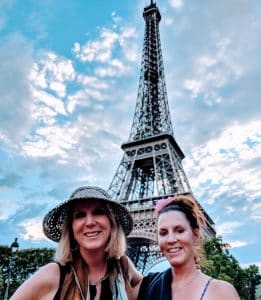
“Six Eiffel Tower, one Euro,” says the first of many African vendors who approach us during the course of the evening. They sell Eiffel Tower keychains, six for one Euro—perfect little travel-friendly souvenirs to take back to kindergarten children, half-witted neighbors, and senior citizens with fading memories of the war. Twenty bucks and you could have cocktail party favors for the next five years.
“Six Eiffel Tower, one Euro.”
Non, merci. Non, merci. Non, merci.
These are the first words of French Randy learns to speak. More than this she does not need.
“I wonder what George Benson is doing tonight,” says John, looking out at the swelling crowd.
“I don’t know, but I bet he’s not here,” I say.
“Why not?’ says John. “Everyone else is.”
There’s an accordion player on one side of the Trocadero; a rapper with head-spinning break-dancers on the other. In the middle lane, half-naked daredevils navigate an obstacle course on skateboards and other wheeled devices. This reminds me of a game Randy and I used to play when we were teenagers, called “Let’s Go Die.”
We join the blob of people ambling across the bridge, then shuffle past security checkpoints into the swarm of puffy-shoed holidaymakers standing under the tower.
When I gaze up, I feel tiny.
The early evening sun seems hammered in the sky. People are undressed to suit the heat. Side boob, butt cleavage, full-bikini belly-up outfits—there’s a lot of flesh on display for a city that prides itself on haute couture. No MAGA hats or other Trump-wear, so that’s a plus.
“Side boob?” says John. “Really? That’s a thing?”
“There’s also under-boob,” I say, pointing out a young woman who might as well be topless. My husband and I have reached the marital stage where we point out attractive people to each other.
“Look at that,” I say to John. “It’s Nipple Day at the Eiffel Tower.”
“Bless her heart,” he replies.
I actually enjoy seeing all the body parts hanging out with no one groping or grabbing or even staring much. Josephine Baker would approve. My side-boob days are behind me, but I would truly enjoy wearing a string of bananas around my waist.
A perspiring French gospel choir sings “Stand by Me.” Then they sing “Lean on Me.” It’s a medley of me songs. Or moi songs.
After reaching the grassy field adjacent to the tower, we search for a place to sit and and wait for the tower lights to come on. What luck! John spots a vacant bench on the edge of the first lawn—prime seating and big enough for the four of us.
“Six Eiffel Tower, one Euro.”
Non, merci.
“I will get us something to drink.” In addition to the keychain guys, there are men everywhere selling beverages of questionable origin. But I am parched in Paris and I want wine.
“One glass wine, eight Euros,” says the vendor.
He has no change, so he gives me the entire bottle of rosé swill for ten bucks. We drink a little, but it tastes like French insecticide, so I go to the next bench and offer the remainder of my bottle to a middle-aged American couple. They are from Wisconsin and on their honeymoon. I congratulate them.
“Thank you,” says the wife. “We’re here with my two teenage daughters. We’re a patchwork family now—my girls are from my first marriage. Oh look, here they are!”
Right on cue, two pissed-off teenagers stomp around the corner and fling themselves on the bench. They are tap-tap-tapping on their devices.
“These are our girls, Brittany and Whitney. Brit and Whit. Girls! Say hello to this nice lady. She’s American!”
I’m not sure if I should salute or take a knee.
“Brittany, I love your hair braided like that,” says the husband to the younger of the two girls.
“WHAT KIND OF SNARKY COMMENT IS THAT SUPPOSED TO BE?” says Brit.
“I mean, it looks pretty. It’s nice to see your face.”
“WHAT ARE YOU, A PERV?” shouts Whit. “LEAVE US ALONE.”
“Come on, Brit and Whit,” says the mom. “Your step-dad is trying to be nice. Isn’t it a beautiful Parisian evening?”
“Perv,” mutters Brit.
“Creep,” says Whit.
Neither one of them looks up. Tap, tap, tap.
I excuse myself and scuttle back to the safety of my own bench.
“I heard that!” says John. “ Awful. Their nice mother brings them to Paris and they can’t even stop playing with their phones long enough to look up at the Eiffel Tower?”
“Maybe they don’t like the step-father,” I say.
“Maybe. But still, they’re in Paris. You’d think they’d show a little gratitude.”
“They’re from Wisconsin,” I say, as if that means anything.
It’s then that Randy points out the man on the bench on the other side of us—a street person dressed in colorful rags and eating a jar of mayonnaise with his fingers. His boots are tied to his feet and a stream of urine runs under his bench. No wonder—in a park crammed with tourists—our bench had been empty.
“Call me crazy, but I think that bum is a fake,” says Randy.
“A fake bum?” I say. “Who would fake being a bum?”
“Look at him. Cleanly shaven. And he’s really handsome. Movie star handsome. Lenny Kravitz in a bum costume. And his clothes, even though they are bum-like, have a certain colorful, artistic flair.”
“Yeah, well it’s Paris,” says Dale. He’s still disappointed about the Benson laryngitis debacle. Dale has been carrying a book of poetry, wearing a hat that looks slightly French, and is considering smoking a Gauloise to appear more authentic.
“Maybe the bum is an actor studying for a part.”
“Well that’s some realistic sense-memory stuff with the pee and everything,” I say.
“He’s sexy. Hot,” says my sister. “Clean him up and, just saying . . .”
“Six Eiffel Tower, one Euro.”
Non, merci.
Leave it to my sister to conjure a sex fantasy about a French bum.
“Look at those cheekbones,” she says. “And I can tell he’s buff underneath that tattered coat.”
The bum disappears into some bushes, directly behind where we’re sitting.
“Regardez!” says Dale. “He has a camp back there. A bum camp.”
“What, for food condiment storage? He surely isn’t using it for a toilet—he has that covered out here.”
“Maybe that’s where he shaves,” says Dale. “His skin is very smooth. You need a really good razor to get a shave that smooth.”
“We should move,” says John.
“Non, non!” my sister and I yell in unison.
“This is prime seating,” Dale says.
I’ll say. We stare straight ahead and wait for the lights. I worry about the bum eating mayonnaise in this heat and getting food poisoning. I worry about the razor. I worry that in his bum camp—a mere five feet away from us—he has a collection of beret-clad heads in a big basket.
“You know, new Banksy paintings were just discovered in Paris,” says John. “Maybe the bum is not a bum. He could be Banksy.”
Perhaps I’m suffering from heatstroke, but I think there’s merit to John’s premise. Banksy, an anonymous street artist, has become wildly famous. I’ve always thought Banksy could be a woman. But I like John’s bum theory.
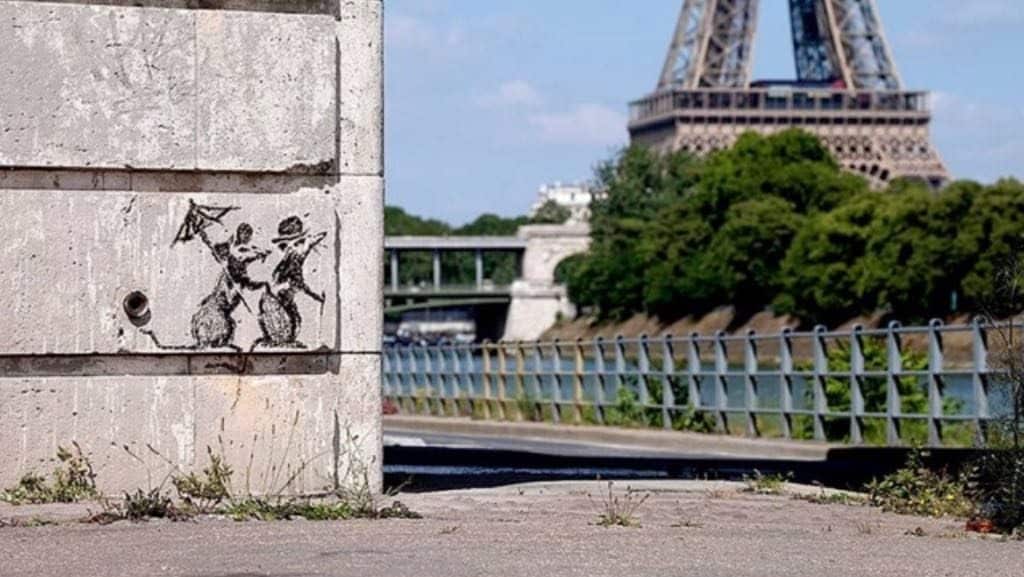
Having the bum, or Banksy, or whoever he is rustling around in the shrubs behind us makes me anxious; I’m not in the mood to get splattered with urine, mayonnaise, or paint. Or shaving cream.
We hear swishing noises. A rat leaps out of the bushes and darts around our feet.
“Shit!” I yell, as I jump up. “La grosse souris. Le rat.”
Randy, an animal lover, says: “Look how cute he is. Hey there, buddy. So sweet! I think he’s Banksy’s pet. It’s like that Ratatouille movie.”
“Six Eiffel Tower, one Euro.”
Non, merci.
Animals are sacred to my sister. Over the years she has raised horses, dozens of rescued dogs and stray cats, and two enormous Vietnamese pot-bellied pigs named Backhoe and Moser. When she was a kid she trained a hog named Hefner, cared for a tarantula named Bogart, and coaxed Walter the pigeon back to health. Over the years she entertained numerous squirrels, baby birds, mice, and a chimpanzee. While I was learning the lyrics to every Carole King song ever written and memorizing Bach inventions, Randy was working in the Twilight exhibit at the Pittsburgh Zoo and making friends with the bats.
Randy currently has a collection of large snakes that she uses for therapy sessions at a juvenile detention center in Butler County. We don’t call her Badass Randy for nothing.
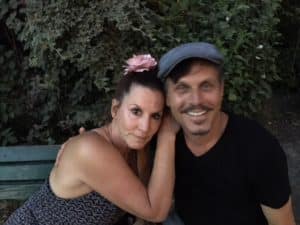
“Look how beautiful the Eiffel Tower is,” says Randy. I am not sure if she’s talking to me or the rat, but she’s clearly enchanted. Stifling heat, a cancelled concert, whining girls, bad rosé, and a fake bum—nothing will get in the way of her infatuation with Paris, at least not tonight.
Meanwhile, next door in teen-scream-horror-queen central we hear Brit-Whit’s mom say: “Look at that sunset! Brit, will you take a photo of your step-dad and me in front of the tower?”
“DO I HAVE TO?” asks Brit.
“Please, honey?”
“OKAY. BUT JUST ONE. THIS IS STUPID. THIS IS A STUPID SHITHOLE CITY.”
You can call Paris a lot of things, but shithole is perhaps not one of them.
“EXACTLY,” says Whit. “THIS PARIS SHITHOLE IS FULL OF CREEPS.”
Creeps? Creeps?
I look at Dale in his French hat, Banksy slouched in his pool of pee, my husband in his sixtieth-anniversary Grammy baseball cap, my sister talking to the rat, the half-naked side-boobed people taking demi-showers in the water fountains meant for drinking, and the Senegalese vendors shuffling through the park with keychains strapped to their arms. I think maybe she has a point.
Paris—from the perspective of a self-absorbed fifteen-year-old American girl—seems full of spooky people. But so does Disneyland. Is there anything more disturbing than those over-fed Americans stuffed into that Small World ride? I think not. Or what about the Wisconsinites who attend sporting events with foam swiss-cheese sculptures strapped to their heads? And don’t even mention SeaWorld, Trump Tower, Vegas, or Graceland. It’s all unnerving. Creepy.
Brit-Whit, trapped in a phase from which they will someday escape, are suspect of everyone, especially what’s unfamiliar or foreign. Hopefully they’ll come to their senses before their patient mother throws herself in the Seine.
“I can’t stand the way these girls are treating their mother,” says John. “Randy—go say something to them.”
“I’ve got this,” says my sister, who has raised four kids of her own. “Too bad I don’t have my snakes with me.”
“Be nice,” I say to my sister. “Remember, once upon a time we were also obnoxious teenagers.”
“Yeah,” she says. “But no one brought us to Paris.”
“True,” I say. “But I did refuse to get out of the car at the Grand Canyon. And you pitched a fit over the captain on that deep sea fishing expedition in Cape Hatteras.”
“That was justified,” she says. “He was holding a machete, leering at my ass, and chopping up chum for sharks.”
Randy brushes me aside and approaches Brit-Whit. “Hi there, girls! Don’t you just love Paris? Your Taylor Swift t-shirts are just darling, although I’m more of a Béyoncé fan. Did you see the tour posters for her new show with Jay Z?”
Nothing. Tap, tap, tap.
“This is my first trip to Europe, too, and I’m almost sixty. And just think, you’re here as teenagers. Aren’t you lucky that your mom brought you along on her honeymoon? How was the wedding? Were you bridesmaids? Did you have cute dresses?”
Scowl.
“How old are you? What are your hobbies? Are you enjoying French food?” Undeterred by their silence, Randy, like a grinning bull terrier, keeps yipping questions at the girls.
“Who’s your favorite artist? Isn’t Paris dazzling? Someday, you will remember this trip as a highlight of your teenage years. Someday, you’ll be really grateful that your mom brought you here.”
“Right,” Brit mumbles. “Shithole.”
“Speak up, honey,” says her mother.
Nothing. Tap, tap, tap.
“Oh. I apologize for the girls—Brit and Whit are still getting used to their step-father and their new siblings.”
“You lucky girls!” says Randy. “A patchwork family means double love!” says Randy. “Double pleasure!”
The creep factor has now gone off the charts. I drag Randy back to our bench before she starts doing “Single Ladies” choreography or asks to take a selfie with the two of them. Later, I will wish we had gotten the photo. We could have captioned it: Thank heaven for little girls.
Banksy the bum returns to his bench with a new jar of mayo.
At last. The tower begins to blush and smolder in the dusky sky. Our accidental neighbors have now become a pesky, but central part of our George Benson-less impromptu evening. We’re not where we intended to be, but maybe we’ve landed in exactly the right place—stuck between a movie-star handsome French derelict and a dysfunctional family from Wisconsin—watching the Eiffel Tower lights effervesce like a shaken bottle of cheap champagne.
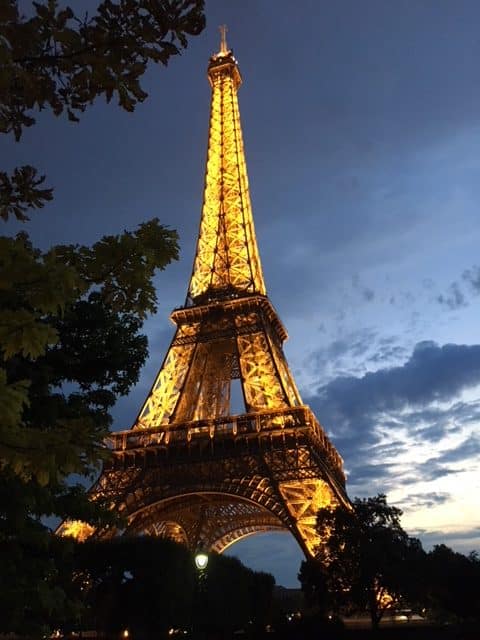
Twinkle, twinkle, little star. Sizzle, crackle, creep. That’s Paris for you, at least during the summer months. Through a twilight prism I see parts of myself in every person here—the mundane, insane, broken, outspoken, rich-bitch, poor-whore, hustling-bustling, glam-scam, defeated, conceited, mistreated, cheated, hell-raising, trailblazing, butt-gazing visitors to one of the world’s most spectacular man-made structures.
Unlike Randy, I do not identify with the rat.
I look around and wonder who else in the crowd feels as grateful as I do right now. Maybe my sister. We could probably join hands and outrun the desperation and beauty surrounding us, but instead we stay in place, bench-bound, and face the full-bodied heat of the city.
“Six Eiffel Tower, one Euro.”
Non, merci.
*****
Note: We hang out with George Benson a few days later. But that’s another story. Stay tuned.
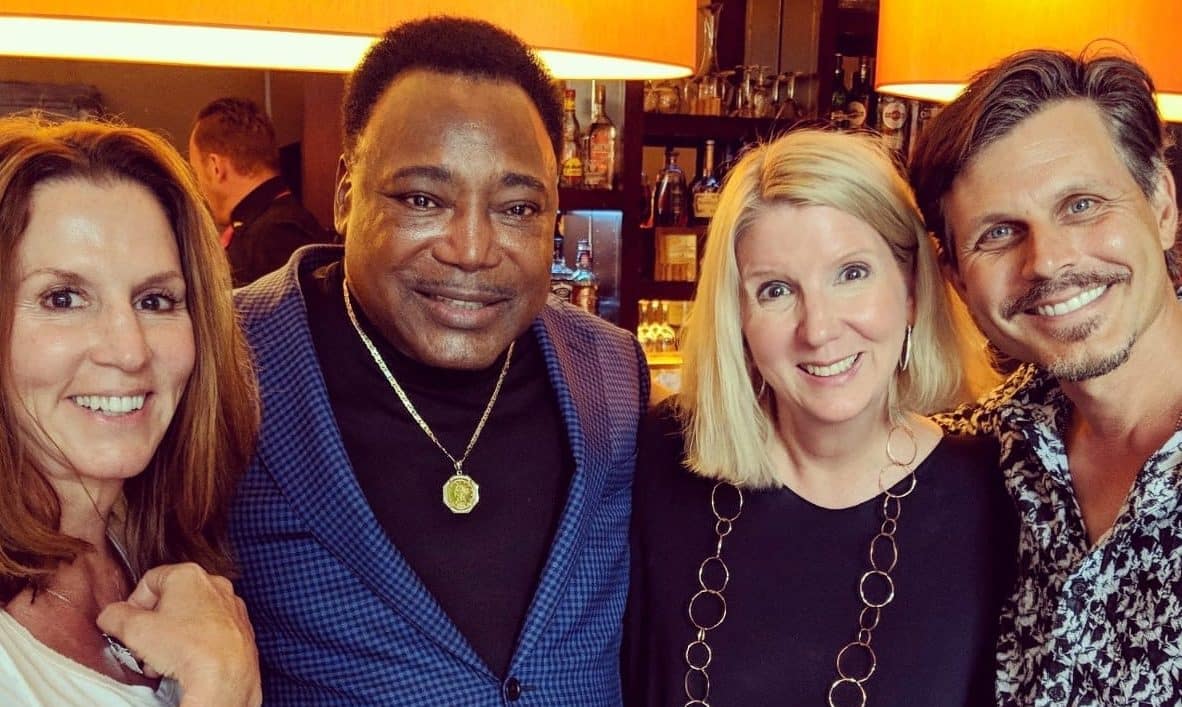
Special thanks to my dear friends Deborah and Jon Lillian, who—against the odds—hosted a vegan cocktail party for us in Paris.
Robin Meloy Goldsby is a Steinway Artist. She is the author of Piano Girl; Waltz of the Asparagus People: The Further Adventures of Piano Girl; and Rhythm: A Novel.
Newest book: Manhattan Road Trip, a collection of short stories about musicians. Go here to buy Manhattan Road Trip!
New piano album: Home and Away, Goldsby’s latest solo piano album, directly from the artist, at Amazon, or from your favorite streaming channels.
Sign up here to receive Robin’s free newsletter. A new essay every month!
